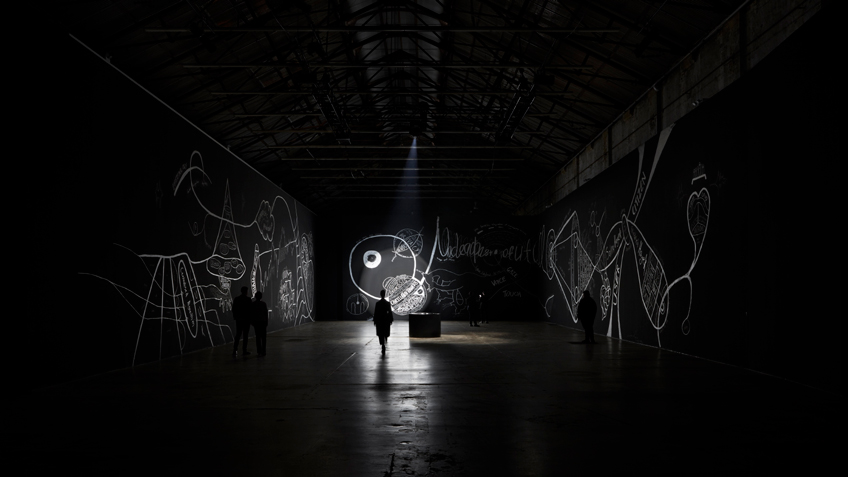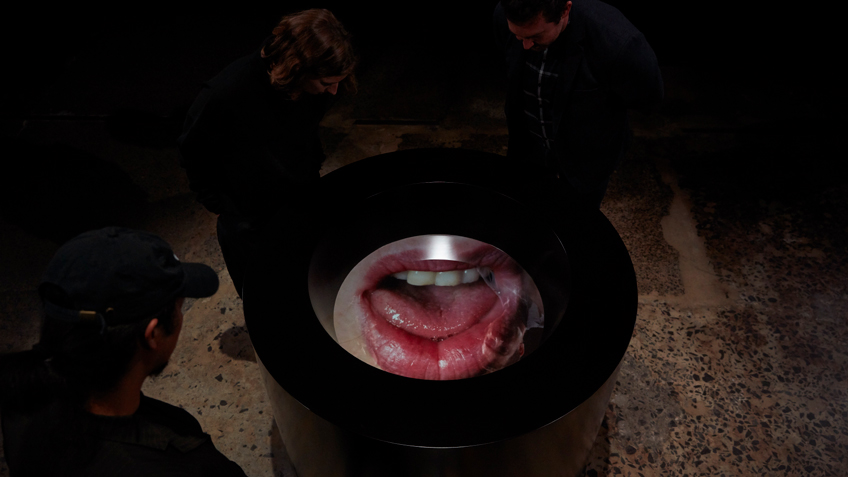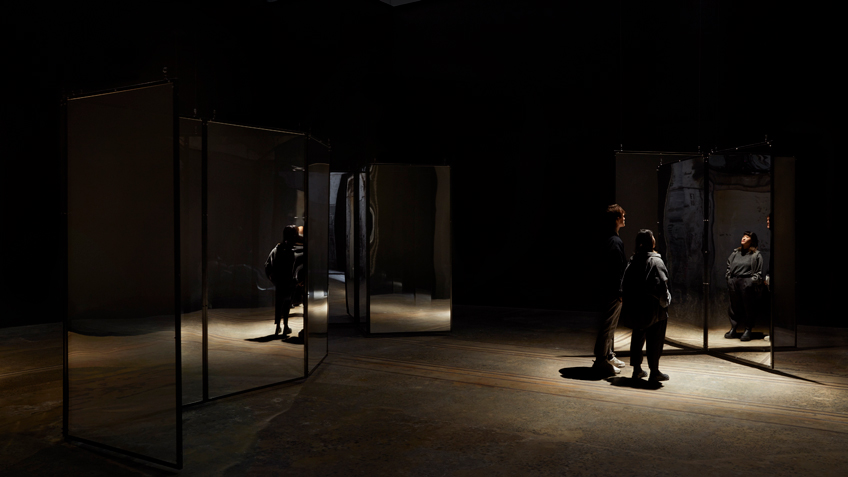Cinopticon curator Daniel Mudie Cunningham unpacks Giselle Stanborough’s immersive exhibition.
Visibility is a trap — Michel Foucault
According to the website Know Your Meme, it was Tumblr user prufrocking who in 2012 first breathed new life into Jean-Léon Gérôme’s painting Truth Coming Out of Her Well to Shame Mankind (1896). In posting a low-res jpeg of the painting on social media, prufrocking sparked a series of witty memes that rescripted the painting’s contents, giving it renewed viral currency in a digital context.
Gérôme’s classical painting depicts a naked woman (‘truth’) emerging out of a well, her shocked expression and penetrating gaze affronting the viewer (‘mankind’). A master of allegorical painting, Gérôme’s gendered take on truth updates Democritus, the pre-Socratic Ancient Greek philosopher, who said: ‘Of truth we know nothing, for truth is in a well.’ Four years after the painting and two before he died, Gérôme wrote the preface to Émile Bayard’s photo book Le Nu Esthétique (1902). In it he returns to the metaphor of truth and the well to explain the camera’s profound influence on a century that would ultimately be transformed by the power of the photograph. Even better than the real thing of a realist nude in oils, the photograph supposedly brought truth out of the dark. Or, the abyss, to cite another translation of truth’s well.
Entering the dark, almost empty space of Cinopticon is an encounter with this abyss. Situated in the middle of the void is a well protruding from the ground, illuminated as a roaming spotlight/searchlight passes its modest silhouette. Inside the well is artist Giselle Stanborough, whose fragmented screen image morphs with a viewer’s self-reflection as they edge forward and peer into the well. Giving truth to the idea that we project our own desires and narcissistic fantasies onto the images we crave and consume, Democritus and Gérôme’s well is reinstated by Stanborough for a post-photography and post-truth era obsessed by a cult of wellness. As the subject and object of her own system of visual scrutiny, Stanborough is the ghost in her own machine. She literally haunts its house of mirrors, trapped as a digital apparition at the bottom of the well.
—
Internet narcissism, corporate surveillance and the manipulation of social media algorithms are touch points for Cinopticon—an immersive performance installation where audiences see their reflection in unpredictable ways. Cinopticon contemporises Foucault’s theory of the ‘panopticon’, a model of surveillance where the few watch—and control—the many. Today, with technology at our fingertips, we watch each other.
In Cinopticon various elements are abstracted through a prism of self-reflection. Motivated by the collapsing distinction between the public and private realms of contemporary life, Stanborough creates an unsettling and strange environment activated by image, sound and light. At the heart of its sensory quest, Cinopticon probes what it means to both be watched and watch others.
Stanborough’s practice is primarily concerned with the relationship between connectivity and isolation, public and private. Over the past decade, her work has consistently addressed how fast evolving media technologies encourage us to perform our private selves, publicly, all of the time. As the recipient of the Katthy Cavaliere Fellowship for Carriageworks, Stanborough shares some of the conceptual concerns that preoccupied Cavaliere in her lifetime. A mutual interest in performances of self and the tensions between what is exposed and what is kept hidden or held back from view animates both their practices.
Cavaliere’s work was confessional, always laying bare deeply affecting personal narratives pertaining to childhood memory and migration, familial relationships and grief. It was like she sat within the dream world she constructed, isolated and independent, as if no one was watching but she was a spectacle and audience ready nonetheless. It is productive to think about Stanborough in similar terms given her practice unpacks the ethics and impulses tethering public spectatorship to personal revelation.
A case in point is Stanborough’s early work That Really Hurts and It’s Still Hurting (2012). For this installation, a silent digital projection of the artist performing a confessional vlog to camera (that cannot be heard) is overlaid by a 35mm slide projection of YouTube screen captures cataloguing home videos of children called Giselle. As the carousel progresses to the next slide of, say, ‘Kite flying at Giselle’s birthday party with her friends,’ a ghost-like Stanborough is inserted in the interface of the YouTube web browser. Created in response to the loss of her childhood photos that were destroyed when her father remarried, the installation is a precursor to TikTok with the sound turned down. It suggests that today’s digital phenomenon of ‘going viral’ as a spectacle for public consumption is a flipside to photography as an analogue totem of memory and truth, susceptible to loss and ruin, or remediation.
Almost a decade later with Cinopticon, Stanborough similarly uses her personal archive, but ditches the photographic archive for an acousmatic vocal soundtrack that narrates fragments of online activity through web comments, browsing habits and smartphone engagement. The influence for these soundbites stems from the way users mime audio snippets on TikTok, an app for short-form mobile videos that are shared by millions. For Stanborough this spoken text chronicle is as deeply personal and emotive as it is generic and boring; individualising on the one hand and anonymous on the other—much like the logic of TikTok.
Painted black, the tall walls of the gallery at Carriageworks are a chalkboard for cryptic markings in white paint. Ominous and obsessive, the scrawled notations take shape as a mind-map or meme, plotting algorithmic connectivity in order to unpack the sinister workings of surveillance in daily life. It is an analogue diary of digital paranoia. The work of a wellness blogger speaking her truth. Conspiracy theories for dummies. Or better yet, docile bodies self-regulated under Foucauldian biopower. ‘You’ll never know what a body can do if you are preoccupied by what a body looks like,’ speaks the well to the wall.
Located in the well and on the wall further back into the gallery space are video images of Stanborough as a body in pieces. Reflective film is applied to the video surface, allowing audiences to morph their reflection with the artist’s fetishised body—a technique that echoes the analogue/digital ghosting in That Really Hurts and It’s Still Hurting. Using imaging conventions drawn from internet ‘bubble porn’, Stanborough uses negative space to sexualise an image to create desire, drawing attention to the way stimulation is aroused through lack and by the gaze. To gaze upon her body in this way is like seeing it through an aperture, peephole or portal, a conscious nod to Cavaliere’s figment (1997), a photographic installation where the artist’s body explodes into an erotic constellation of parts.
The voyeuristic and narcissistic registers of the gaze are amplified in Cinopticon through an installation of mirrors that allude to what Shoshana Zuboff calls ‘surveillance capitalism’. Writing in The New York Times, Zuboff says the ‘success’ of surveillance capitalism ‘depends upon one-way-mirror operations engineered for our ignorance and wrapped in a fog of misdirection, euphemism and mendacity.’ Zuboff continues, ‘It rooted and flourished in the new spaces of the internet, once celebrated by surveillance capitalists as “the world’s largest ungoverned space”’. Stanborough reiterates this idea but through a two-way mirror where the reflective surfaces switch between acting as a mirror and a window—and a stage on occasions when Stanborough performs in the installation. As the lighting changes in the space, the artist may appear and dissolve, shifting between presence and absence. ‘When they can see me, I can see me, and when they see their reflections, I can see them’ Stanborough explains.
When performing live within the work, Stanborough’s physical movement has been choreographed according to the way bodies are scripted under surveillance capitalism.
Hand swipes, taps, shakes
Eyes downcast as if gazing at a phone
Neck rotates, shoulders roll to combat repetitive office labour
Steps mimic exercise routines
Head, shoulders, knees and toes
Built into her performance are movements where exercise regimes and dance sequences become one and the same. Under a disciplinary and self-regulating gaze, both are indistinguishable and understand that a body seen is more important than a body being. We spend all our time focusing on what the body does, should do, and making sure we do it with precision and in accordance with the discourse of the ‘master’. Stanborough illustrates this by appropriating popular TikTok dance sequences as examples of disciplinary power made fun for a social media generation.
Accompanying the IRL experience of Cinopticon is a program of online journal content where Stanborough extends the digital footprint of her ideas. Originally, a plan to re-perform Cavaliere’s a moment alone (1998) within the exhibition space was abandoned as COVID-19 and social distancing jettisoned a number of planned performance events. Just as Cinopticon’s wall mural can be read as a random stream of consciousness, Cavaliere wrote private notes to herself on the gallery wall while perched on a chair three metres high. With her back to the audience below, Cavaliere externalised private thoughts in public, her scrawling text becoming obscured and illegible as overlapping sentences took form. In place of this restaging, a nod towards Cavaliere’s work is made with Cinopticon: Vlog, an online video where a hypnotic voiceover links psychoanalysis and everyday life. Instructional yet absurdly discursive, the interior monologue wavers in and out of sync with a talking avatar of the artist which floats over imagery of diagrams and drawings being composed as if in a strange waking dream.
—
When I was a child my family lived in an old house that had a bomb shelter. The carpet in my bedroom covered the trap door once leading to it. My brothers and I accessed it by going under the house and down concrete stairs once concealed by a gate that had perished, exposing the shelter to the elements. We used it as a hiding place away from the authorial gaze of our parents. Our secret clubhouse stockpiled with books and canned food stolen from the kitchen. When it rained, the shelter filled up with water and we called it The Well.
A place of hiding or a source of hydration, today The Well is more than a hole in the ground, a symbolic site of the repressed. My Well is the phone in my pocket alerting me to my daily screen time, offering digital wellness, tracking my every move, updating my feed with COVID-19 updates about looted supermarket shelves, cancelled public gatherings and enforced social distancing. Welcome to an era where memes and mass panic are one and the same.
If visibility is now a trap door, Cinopticon‘s well is its thirst trap.


